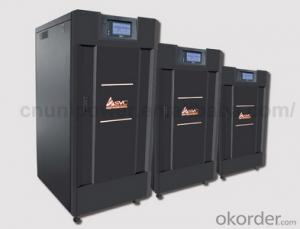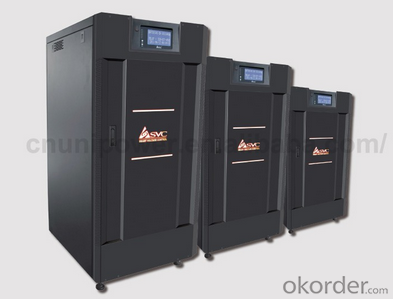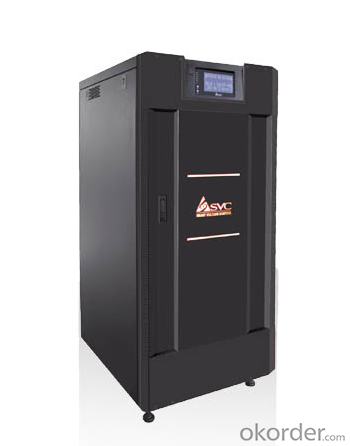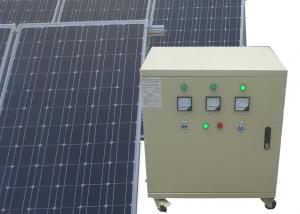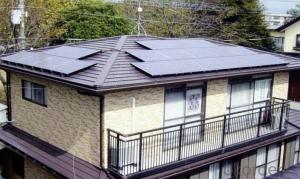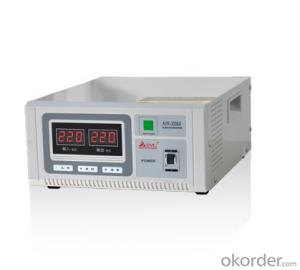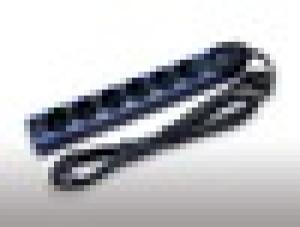Nexus Solar Energy Systems UPS Types Office Equipment Low Frequency 20~200kVA Front Office Equipment
- Loading Port:
- China main port
- Payment Terms:
- TT OR LC
- Min Order Qty:
- 20 carton
- Supply Capability:
- 10000 carton/month
OKorder Service Pledge
OKorder Financial Service
You Might Also Like
Online Low Frequency 20~200KVA UPS Types Front Office Equipment
| MODEL | GP33-20-30 | GP33-40-60 | GP33-80-100 | GP33-120-200 |
| Capacity | 20~30KVA | 40~60KVA | 80~100KVA | 120~200KVA |
| Type | Tower | |||
| INPUT | ||||
| Voltage | (208 or 380 or 400 or 480 Vac) ± 20% / 5 wires (3 Lines + Neutral + Ground) | |||
| Frequency | 50 or 60Hz ± 10% Autosensing | |||
| Power factor | 0.98 | |||
| Filter | EMI, RFI | |||
| Dual input | Optional | |||
| OUTPUT | ||||
| Voltage | (208 or 380 or 400 or 480 Vac) ± 20% / 5 wires (3 Lines + Neutral + Ground) | |||
| Frequency | 50 or 60Hz ± 0.1% | |||
| Effciency | AC / AC > 92% | |||
| Trandfer time | 0 ms | |||
| Wave form | Sine wave | |||
| Power factor | 0.9 | |||
| Voltage T.H.D. | < 2% with linear load< td=""> | |||
| Crest factor | 3 : 1 | |||
| Technology | True on-line double conversion controlled by microcontroller | |||
| Overload recovery | Automatically transfer to UPS mode | |||
| Isolation transformer | Inverter mode ( bypass mode is optional ) | |||
| Parallel connection | Parallel connection function is ready (extra PCB is not required ) | |||
| BATTERY | ||||
| Battery type | VRLA ( Valve Regulated Lead Acid ), not included | |||
| DC voltage | 384 Vac | 480 Vdc | ||
| Charging time | 4 hours up to 90% | |||
| Battery detection | self-detect, transfer to battery mode adjustable | |||
| PROTECTION | ||||
Lighting and transient protection | Hotswappable lightning and transient surge suppressor (In:10 Kamp, Up:1.5 Kv, I max : 20 K amp. ) | |||
| Hardware protection | output breaker, battery breaker, bypass breaker; DC fuse, fan, redundant power supply; temperature sensor, EPO (Emergency Power Off), audible alarms etc. | |||
| Software protection | Discharging batteries, battery charge working mode, inverter working mode, emergency power off, manual shutdown, bypass SCR failure, bypass sequence failure, bypass over the lilit, critical overload, batteries exhaustion, low or high output voltage, DC fuse open, 5v power supply failure, 13.5V power supply failure, inverter overvoltage, 200% overload on each line, transfer failure, inverter voltage out of range, over voltage between neutral and ground, UPS on bypass mode, bypass frequency out opf range. | |||
| Bypass | Solid state | |||
| Overload | 125% for 10 min, 150% for 30 sec, 1000% for 16 millisencond. | |||
| EPO | EPO local and / or remote | |||
| Display | LCD, touch screen | |||
| LED's diagram | Included | |||
| Communication | RS232 intellident Slot, modem, SNMP(RJ45) (SNMP adaptive Software is supplied by the producer) | |||
| ENVIRONMENT | ||||
| Elevation | 1.700 m.o.s. 1 without derrating | |||
Temperature & noise | 0℃~40℃ / < 60db @ 1.5m.< td=""> | |||
| Humidity | Non condensate | |||
| PHYSICAL | ||||
| Dimension(mm) | 520*1600*550 | 520*1670*780 | 1000*1860*870 | Ask for information |
Weight (without batteries) | 150 | 300 | 600 | |
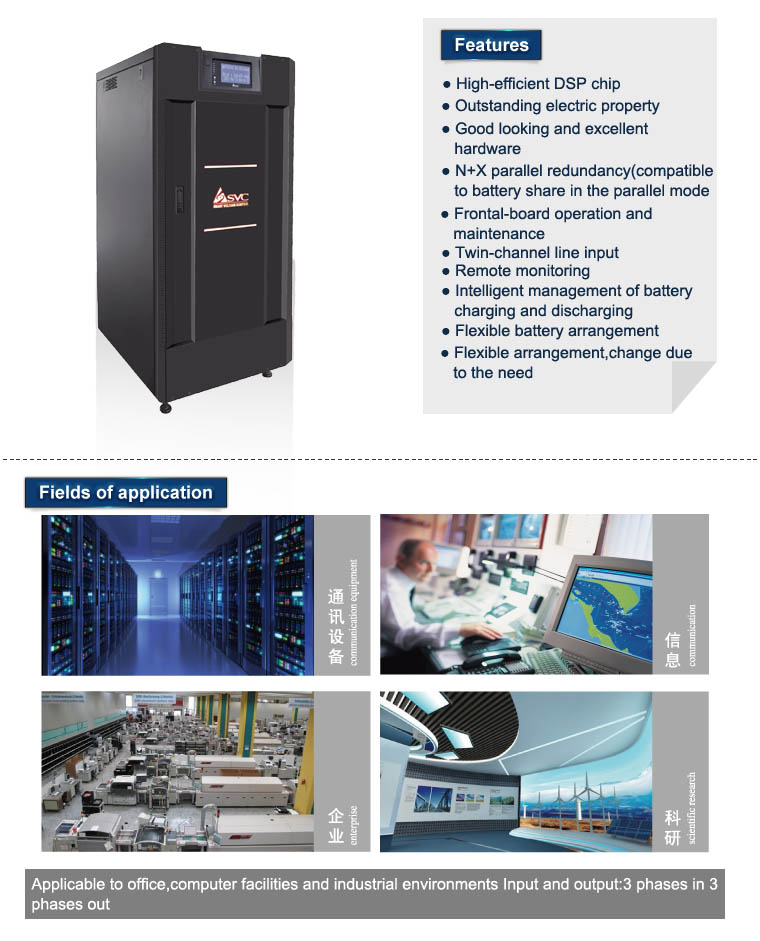
Product Description

1. Wide range of input voltage
The UPS can offer normal and stable service voltage under its input voltage range. When the input voltage is out of its range the machine will switch to battery mode automatically to keep the output power in order to protect the equipment, such as computers, ensure they will not be damaged by the over high or over low voltage, users can continue the operation of equipment for a while or save the data on computers while the power network is abnormal.
2. Wide range of AVR(Automatic voltage regulation)
In the product’s input voltage range and under 3 steps of intelligent AVR function, it can provide a stable output voltage.
3. Automatic self detection when UPS on(LED).
Before the UPS on, red, yellow, blue LED will light up two times by cycle turns, after self detection UPS switch to AC mode/battery mode or working mode.
4. Silence function
In the "battery mode", shortly press the switch to turn off the buzzer. But the battery is about to run out or the load is too heavy, the buzzer sound cannot be muted.
5. Overload protection
In the battery mode, output voltage turn down correspondingly when it is overload, after the capacity of load is lower than the rated power then output voltage will back to rated value, it ensures the UPS will not shut down by abrupt overload which caused by surging current during the computer is working and other equipment is added.
6. Short circuit protection
When the mis-operation caused the load short circuit or computer failure (such as power tube breakdown of switch) cause short circuit, the UPS will shutdown automatically for protection.
7. The low current switch
This UPS adopts low current switch to extend the service life which is longer than conventional battery and high current switch in AC current path.
8. Automatic charging
There are two charging mode, charging time is faster than ordinary charging mode, higher efficiency, and greatly prolonging the service life of the battery.
9. With a bypass output
Independent bypass output socket for external printers or scanners of computer peripherals, with surge protection of the load.
- Q: Can solar energy systems be used in areas with limited access to solar connectors and cables?
- Yes, solar energy systems can be used in areas with limited access to solar connectors and cables. Off-grid solar systems, also known as standalone solar systems, can be installed in remote locations without relying on a traditional electrical grid or extensive wiring infrastructure. These systems typically include solar panels, batteries for energy storage, and inverters to convert the captured solar energy into usable electricity. By storing excess energy in batteries, these systems can provide power even when sunlight is not available, making them suitable for areas with limited solar connectors or cables.
- Q: Can solar energy systems be used for powering electric boats or yachts?
- Yes, solar energy systems can be used to power electric boats or yachts. Solar panels can be installed on the deck or roof of the boat to harness sunlight and convert it into electricity. This renewable energy source can then be used to power the boat's propulsion system, as well as other electrical equipment on board.
- Q: What is the impact of temperature on solar energy system performance?
- The impact of temperature on solar energy system performance is that higher temperatures can decrease the efficiency of solar panels, leading to reduced power output. This is because the materials used in solar panels are sensitive to temperature and can experience a decrease in voltage and current production as temperature increases. Therefore, it is important to consider temperature variations when designing and installing solar energy systems to optimize their performance.
- Q: Can solar energy systems be installed on commercial buildings?
- Yes, solar energy systems can be installed on commercial buildings.
- Q: What is the impact of temperature on the efficiency of a solar energy system?
- The efficiency of a solar energy system is significantly impacted by temperature. As the temperature increases, the efficiency of solar panels decreases. This is due to the behavior of the semiconductor materials used in solar cells. When solar panels are exposed to sunlight, they absorb photons and convert them into electricity. However, as the temperature rises, the resistance of the semiconductor material increases, leading to a decrease in the flow of current. This phenomenon is known as the temperature coefficient of power. The temperature coefficient of power is usually expressed as a percentage per degree Celsius and varies depending on the type of solar panel technology. Most solar panels have a negative temperature coefficient, meaning their efficiency decreases as the temperature rises. On average, the efficiency of solar panels can decrease by around 0.5% to 0.8% per degree Celsius increase in temperature. Additionally, increased temperatures can also cause thermal losses within the system. Heat can build up within the solar panels, reducing their efficiency further. This is especially true in hot climates or during periods of high solar irradiance. To mitigate the impact of temperature on solar energy system efficiency, various strategies can be employed. One common method is to incorporate cooling mechanisms, such as ventilation or water circulation, to dissipate the excess heat generated by the solar panels. This helps maintain lower operating temperatures and consequently improves the overall efficiency. Furthermore, proper system design and installation techniques can also help minimize temperature-related losses. For example, mounting solar panels with sufficient spacing to allow for air circulation can prevent overheating. Additionally, selecting solar panels with lower temperature coefficients can help mitigate efficiency losses in high-temperature environments. In conclusion, temperature has a significant impact on the efficiency of a solar energy system. Higher temperatures can cause a decrease in the efficiency of solar panels, primarily due to increased resistance in the semiconductor materials. To optimize the performance of solar energy systems, strategies such as cooling mechanisms and proper system design should be implemented.
- Q: Can solar energy systems be used in areas with limited grid infrastructure?
- Solar energy systems are indeed suitable for use in areas that have limited grid infrastructure. In fact, one of the key benefits of solar energy is its ability to supply electricity in remote and off-grid locations. By converting sunlight into energy, solar panels generate electricity without relying on a connection to the traditional power grid. This makes solar energy systems an ideal choice for remote areas like rural communities or developing regions, where it may not be financially or technically feasible to extend the grid infrastructure. Through the installation of solar panels and the use of energy storage systems like batteries, these areas can generate and store their own electricity, even when sunlight is scarce or during nighttime. This not only grants access to reliable and clean energy, but also fosters energy independence and resilience in regions with limited grid infrastructure. Moreover, solar energy systems can be easily adjusted in scale to meet the energy demands of the community, making them a versatile and sustainable solution for powering areas with limited grid infrastructure.
- Q: Can solar energy systems be used for powering electric vehicle wireless charging systems?
- Indeed, electric vehicle wireless charging systems can be powered by solar energy systems. These solar energy systems, such as solar panels, have the capability to capture sunlight and convert it into electricity. This electricity can then be utilized to power a wide range of devices and systems, including electric vehicle wireless charging systems. The process of utilizing solar panels to charge electric vehicles wirelessly involves the installation of these panels on either a building or a dedicated solar carport. Once the solar panels are in place, they are able to gather sunlight, which is subsequently transformed into electricity. This electricity can be stored in batteries or directly supplied to the charging system. The utilization of solar-powered wireless charging systems presents numerous advantages. Firstly, it provides a sustainable and renewable energy source, reducing the reliance on fossil fuels. Consequently, this contributes to the creation of a cleaner and more environmentally friendly atmosphere, as solar energy is a clean and emission-free power source. Secondly, solar-powered charging systems can be installed in remote areas where access to the power grid may be limited. This allows for the convenient charging of electric vehicles in locations that lack traditional infrastructure. Furthermore, solar energy systems have the potential to decrease the overall energy expenses associated with charging electric vehicles. By harnessing the power of the sun, electric vehicle owners can benefit from lower operational costs and even have the opportunity to earn money by selling any excess energy back to the grid. In conclusion, it is evident that solar energy systems can undoubtedly be utilized to power electric vehicle wireless charging systems. These systems offer a sustainable, renewable, and economically viable solution for charging electric vehicles, all while reducing the environmental impact and promoting energy independence.
- Q: Can solar energy systems be installed without professional help?
- No, it is highly recommended to have professional help when installing solar energy systems due to the complexity involved in designing and connecting the system to the electrical grid.
- Q: Do solar panels work on cloudy days?
- Yes, solar panels do work on cloudy days, although their efficiency may be reduced compared to sunny days. While they generate less electricity in overcast conditions, they can still produce a significant amount of power due to the diffuse sunlight that reaches them.
- Q: Can solar energy systems be used in areas with limited access to skilled labor?
- Yes, solar energy systems can be used in areas with limited access to skilled labor. Solar energy systems are designed to be user-friendly and require minimal maintenance. Additionally, advancements in technology have simplified the installation process, making it easier for individuals with limited technical expertise to set up and operate solar energy systems. In such areas, training programs and workshops can also be organized to empower local communities and develop their skills to maintain and repair solar energy systems.
Send your message to us
Nexus Solar Energy Systems UPS Types Office Equipment Low Frequency 20~200kVA Front Office Equipment
- Loading Port:
- China main port
- Payment Terms:
- TT OR LC
- Min Order Qty:
- 20 carton
- Supply Capability:
- 10000 carton/month
OKorder Service Pledge
OKorder Financial Service
Similar products
Hot products
Hot Searches
Related keywords
